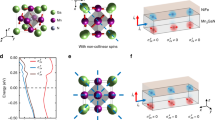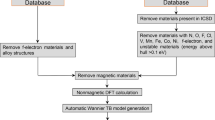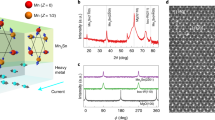Abstract
The spin Hall effect (SHE) is usually observed as a bulk effect in high-symmetry crystals with substantial spin–orbit coupling (SOC), where the symmetric spin–orbit field imposes a widely encountered trade-off between spin Hall angle (θSH) and spin diffusion length (Lsf), and spin polarization, spin current and charge current are constrained to be mutually orthogonal. Here, we report a large θSH of 0.32 accompanied by a long Lsf of 2.2 μm at room temperature in a low-symmetry few-layered semimetal MoTe2, thus identifying it as an excellent candidate for simultaneous spin generation, transport and detection. In addition, we report that longitudinal spin current with out-of-plane polarization can be generated by both transverse and vertical charge current, due to the conventional and a newly observed planar SHE, respectively. Our study suggests that manipulation of crystalline symmetries and strong SOC opens access to new charge-spin interconversion configurations and spin–orbit torques for spintronic applications.
This is a preview of subscription content, access via your institution
Access options
Access Nature and 54 other Nature Portfolio journals
Get Nature+, our best-value online-access subscription
$29.99 / 30 days
cancel any time
Subscribe to this journal
Receive 12 print issues and online access
$259.00 per year
only $21.58 per issue
Buy this article
- Purchase on Springer Link
- Instant access to full article PDF
Prices may be subject to local taxes which are calculated during checkout





Similar content being viewed by others
Data availability
The datasets generated by the present study are available from the corresponding author on request.
References
Wu, S. et al. Observation of the quantum spin Hall effect up to 100 kelvin in a monolayer crystal. Science 359, 76–79 (2018).
Fei, Z. et al. Edge conduction in monolayer WTe2. Nat. Phys. 13, 677 (2017).
Fatemi, V. et al. Electrically tunable low-density superconductivity in a monolayer topological insulator. Science 362, 926–929 (2018).
Sajadi, E. et al. Gate-induced superconductivity in a monolayer topological insulator. Science 362, 922–925 (2018).
Ma, Q. et al. Observation of the nonlinear Hall effect under time-reversal-symmetric conditions. Nature 565, 337–342 (2018).
Kang, K., Li, T., Sohn, E., Shan, J. & Mak, K. F. Nonlinear anomalous Hall effect in few-layer WTe2. Nat. Mater. 18, 324–328 (2019).
MacNeill, D. et al. Control of spin–orbit torques through crystal symmetry in WTe2/ferromagnet bilayers. Nat. Phys. 13, 300 (2016).
He, P. et al. Observation of out-of-plane spin texture in a SrTiO3 two-dimensional electron gas. Phys. Rev. Lett. 120, 266802 (2018).
Kimata, M. et al. Magnetic and magnetic inverse spin Hall effects in a non-collinear antiferromagnet. Nature 565, 627–630 (2019).
Sinova, J., Valenzuela, S. O., Wunderlich, J., Back, C. H. & Jungwirth, T. Spin Hall effects. Rev. Mod. Phys. 87, 1213–1260 (2015).
Liu, L. et al. Spin-torque switching with the giant spin Hall effect of tantalum. Science 336, 555–558 (2012).
Hirsch, J. E. Spin Hall effect. Phys. Rev. Lett. 83, 1834–1837 (1999).
Kimura, T., Otani, Y., Sato, T., Takahashi, S. & Maekawa, S. Room-temperature reversible spin Hall effect. Phys. Rev. Lett. 98, 156601 (2007).
Vila, L., Kimura, T. & Otani, Y. Evolution of the spin Hall effect in Pt nanowires: size and temperature effects. Phys. Rev. Lett. 99, 226604 (2007).
Pai, C.-F. et al. Spin transfer torque devices utilizing the giant spin Hall effect of tungsten. Appl. Phys. Lett. 101, 122404 (2012).
Wang, X., Pauyac, C. O. & Manchon, A. Spin-orbit-coupled transport and spin torque in a ferromagnetic heterostructure. Phys. Rev. B. 89, 054405 (2014).
Gómez, J. E. et al. Spin transport parameters in Ni80Fe20/Ru and Ni80Fe20/Ta bilayers. Phys. Rev. B. 90, 184401 (2014).
Garlid, E. S., Hu, Q. O., Chan, M. K., Palmstrøm, C. J. & Crowell, P. A. Electrical measurement of the direct spin Hall effect in Fe/InxGa1-xAs heterostructures. Phys. Rev. Lett. 105, 156602 (2010).
Ehlert, M. et al. All-electrical measurements of direct spin Hall effect in GaAs with Esaki diode electrodes. Phys. Rev. B. 86, 205204 (2012).
Olejník, K. et al. Detection of electrically modulated inverse spin Hall effect in an Fe/GaAs microdevice. Phys. Rev. Lett. 109, 076601 (2012).
Zhao, B. et al. Observation of spin Hall effect in semimetal WTe2. Preprint at https://arxiv.org/abs/1812.02113 (2019).
Sinova, J. et al. Universal intrinsic spin Hall effect. Phys. Rev. Lett. 92, 126603 (2004).
Guo, G. Y., Yao, Y. & Niu, Q. Ab initio calculation of the intrinsic spin Hall effect in semiconductors. Phys. Rev. Lett. 94, 226601 (2005).
Sun, Y., Zhang, Y., Felser, C. & Yan, B. Strong intrinsic spin Hall effect in the TaAs family of Weyl semimetals. Phys. Rev. Lett. 117, 146403 (2016).
Deng, K. et al. Experimental observation of topological Fermi arcs in type-II Weyl semimetal MoTe2. Nat. Phys. 12, 1105–1110 (2016).
Jiang, J. et al. Signature of type-II Weyl semimetal phase in MoTe2. Nat. Commun. 8, 13973 (2017).
Balakrishnan, J., Kok Wai Koon, G., Jaiswal, M., Castro Neto, A. H. & Özyilmaz, B. Colossal enhancement of spin–orbit coupling in weakly hydrogenated graphene. Nat. Phys. 9, 284–287 (2013).
Kaverzin, A. A. & van Wees, B. J. Electron transport nonlocality in monolayer graphene modified with hydrogen silsesquioxane polymerization. Phys. Rev. B. 91, 165412 (2015).
Völkl, T. et al. Absence of a giant spin Hall effect in plasma-hydrogenated graphene. Phys. Rev. B. 99, 085401 (2019).
Yang, T., Kimura, T. & Otani, Y. Giant spin-accumulation signal and pure spin-current-induced reversible magnetization switching. Nat. Phys. 4, 851 (2008).
Meyer, S. et al. Observation of the spin Nernst effect. Nat. Mater. 16, 977–981 (2017).
Luqiao Liu, R. A. Buhrman, D. C. Ralph. Review and analysis of measurements of the spin Hall effect in platinum. Preprint at https://arxiv.org/abs/1111.3702 (2012).
Valenzuela, S. O. Nonlocal electronic spin detection, spin accumulation and the spin Hall effect. Inter. J. Mod. Phys. B 23, 2413–2438 (2009).
Idzuchi, H., Fukuma, Y. & Otani, Y. Spin transport in non-magnetic nano-structures induced by non-local spin injection. Phys. E. 68, 239–263 (2015).
Zahnd, G. et al. Spin diffusion length and polarization of ferromagnetic metals measured by the spin-absorption technique in lateral spin valves. Phys. Rev. B. 98, 174414 (2018).
He, R. et al. Dimensionality-driven orthorhombic MoTe2 at room temperature. Phys. Rev. B. 97, 041410 (2018).
Britnell, L. et al. Electron tunneling through ultrathin boron nitride crystalline barriers. Nano Lett. 12, 1707–1710 (2012).
Valenzuela, S. O. & Tinkham, M. Direct electronic measurement of the spin Hall effect. Nature 442, 176–179 (2006).
Nakayama, H. et al. Spin Hall magnetoresistance induced by a nonequilibrium proximity effect. Phys. Rev. Lett. 110, 206601 (2013).
Abanin, D. A., Shytov, A. V., Levitov, L. S. & Halperin, B. I. Nonlocal charge transport mediated by spin diffusion in the spin Hall effect regime. Phys. Rev. B. 79, 035304 (2009).
Lesne, E. et al. Highly efficient and tunable spin-to-charge conversion through Rashba coupling at oxide interfaces. Nat. Mater. 15, 1261–1266 (2016).
Ohshima, R. et al. Strong evidence for d-electron spin transport at room temperature at a LaAlO3/SrTiO3 interface. Nat. Mater. 16, 609–614 (2017).
Cui, J. et al. Transport evidence of asymmetric spin–orbit coupling in few-layer superconducting 1Td-MoTe2. Nat. Commun. 10, 2044 (2019).
Wang, Q. et al. Room-temperature nanoseconds spin relaxation in WTe2 and MoTe2 thin films. Adv. Sci. 5, 1700912 (2018).
Kurebayashi, H. et al. An antidamping spin–orbit torque originating from the Berry curvature. Nat. Nanotechnol. 9, 211–217 (2014).
Ciccarelli, C. et al. Room-temperature spin–orbit torque in NiMnSb. Nat. Phys. 12, 855–860 (2016).
Zhang, W. et al. Giant facet-dependent spin-orbit torque and spin Hall conductivity in the triangular antiferromagnet IrMn3. Sci. Adv. 2, e1600759 (2016).
Kresse, G. & Hafner, J. Ab initio molecular dynamics for open-shell transition metals. Phys. Rev. B. 48, 13115–13118 (1993).
Kresse, G. & Furthmüller, J. Efficiency of ab-initio total energy calculations for metals and semiconductors using a plane-wave basis set. Comput. Mater. Sci. 6, 15–50 (1996).
Kresse, G. & Furthmüller, J. Efficient iterative schemes for ab initio total-energy calculations using a plane-wave basis set. Phys. Rev. B. 54, 11169–11186 (1996).
Kuzemsky et al. Electronic transport in metallic systems and generalized kinetic equations. Int. J. Mod. Phys. B. 25, 3071–3183 (2011).
Kleiner, W. H. Space-time symmetry of transport coefficients. Phys. Rev. 142, 318–326 (1966).
Wimmer, S., Seemann, M., Chadova, K., Ködderitzsch, D. & Ebert, H. Spin-orbit-induced longitudinal spin-polarized currents in nonmagnetic solids. Phys. Rev. B. 92, 041101 (2015).
Mostofi, A. A. et al. An updated version of wannier90: a tool for obtaining maximally-localised Wannier functions. Comput. Phys. Commun. 185, 2309–2310 (2014).
Edelstein, V. M. Spin polarization of conduction electrons induced by electric current in two-dimensional asymmetric electron systems. Solid State Commun. 73, 233–235 (1990).
Manchon, A. & Zhang, S. Theory of spin torque due to spin-orbit coupling. Phys. Rev. B. 79, 094422 (2009).
Li, H. et al. Intraband and interband spin-orbit torques in noncentrosymmetric ferromagnets. Phys. Rev. B. 91, 134402 (2015).
Weber, A. P. et al. Spin-resolved electronic response to the phase transition in MoTe2. Phys. Rev. Lett. 121, 156401 (2018).
Acknowledgements
We acknowledge S. Roche for insightful discussions. K.P.L. acknowledges the AME-IRG grant ‘Scalable Growth of Ultrathin Ferroelectric Materials for Memory Technologies’, no. A1938c0035, funded by the Agency for Science, Technology and Research, Singapore. P.S. thanks B. Özyilmaz for providing molecular-beam epitaxy slots and H. Chen for assistance in electron-beam lithography.
Author information
Authors and Affiliations
Contributions
P.S. and K.P.L. conceived the project, P.S. performed device fabrication and electric measurements with help from Y.D. and Y.Z. C.H.H., H.L., V.M.P. and G.V. performed DFT calculations and theoretical modelling. M.Z. performed Raman measurements and exfoliation of h-BN, J.L. performed MBE deposition of Co, W.F. drew part of the schematics and Y.L. helped with figure processing. P.S., C.H.H., V.M.P. and K.P.L. wrote the manuscript with input from all authors.
Corresponding authors
Ethics declarations
Competing interests
The authors declare no competing interests.
Additional information
Publisher’s note Springer Nature remains neutral with regard to jurisdictional claims in published maps and institutional affiliations.
Supplementary information
Supplementary Information
Supplementary Discussion, Figs. 1–15 and Table 1.
Rights and permissions
About this article
Cite this article
Song, P., Hsu, CH., Vignale, G. et al. Coexistence of large conventional and planar spin Hall effect with long spin diffusion length in a low-symmetry semimetal at room temperature. Nat. Mater. 19, 292–298 (2020). https://doi.org/10.1038/s41563-019-0600-4
Received:
Accepted:
Published:
Issue Date:
DOI: https://doi.org/10.1038/s41563-019-0600-4
This article is cited by
-
Acoustic spin rotation in heavy-metal-ferromagnet bilayers
Nature Communications (2024)
-
Giant spin Hall effect in AB-stacked MoTe2/WSe2 bilayers
Nature Nanotechnology (2024)
-
Interfacial magnetic spin Hall effect in van der Waals Fe3GeTe2/MoTe2 heterostructure
Nature Communications (2024)
-
Field-free switching of perpendicular magnetization by two-dimensional PtTe2/WTe2 van der Waals heterostructures with high spin Hall conductivity
Nature Materials (2024)
-
Anomalous spin current anisotropy in a noncollinear antiferromagnet
Nature Communications (2023)



